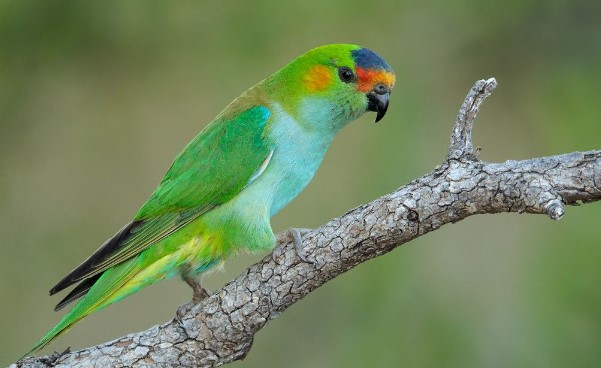Despite the stunning array of colors on the Purple-crowned Lorikeet (Parvipsitta porphyrocephala), it blends amazingly well with the foliage in which it feeds and roosts. These birds usually move in small groups, but in large flocks, sometimes more than hundreds of birds. This colorful lorikeet is also known as Porphyry-crowned Lorikeet, Blue-crowned Lorikeet, purple-capped lorikeet, cowara, purple-capped Parakeet, and Zit Parrot.
The size of the Purple-crowned Lorikeet is approximately 160–165 mm in length, including a short, acute tail. This small parakeet belongs to the family Psittaculidae. Throughout southern Australia, the Purple-crowned Lorikeet ranges north of the Mulga-Eucalypt line in Western Australia and South Australia. Mostly in Victoria, it reaches the south-west of New South Wales, then wanders into southern Queensland.
The purple-crowned lorikeet lives in a wide variety of habitats and is the only lorikeet native to southwestern Australia. Due to its abundance in malle, open woodlands, and dry sclerophyll forests, this species is also fairly common near the coast. This is especially true when inland vegetation reaches the seaboard. Nomadic, follows flowering eucalyptus, and numbers fluctuate unpredictably. No races.
They congregate where flowering eucalypts are plentiful. Among their food sources are pollen, nectar, blossoms, fruits, berries, larvae of insects, and pollen. They also eat cultivated fruits, especially apples, and pears, although eucalypt pollen and nectar are preferred. Orchards can be severely damaged by them.
On the wings and when feeding, they emit sharp screeching notes, allowing observers to get close to them. Purple-crowned Lorikeets nest in hollow limbs or holes in trees, usually, eucalypts standing near the water. The lorikeets often nest in flocks, and the nesting area is packed with activity as the birds flit between feeding areas and nesting.
Each breeding pair cleans out and prepares its nesting hollow, usually in a eucalypt three to forty meters above the ground. The female then lays her eggs on the decayed wood dust lining the hollow bottom. Both birds spend each night in the nest. The female may leave the nest for an hour or so in the morning and evening to feed alone. At other times, the male may feed on her by regurgitation, particularly during courtship.
The purple-crowned Lorikeet, with its pointed wings, has a direct, swift flight with rapid wing beats. It does not fly as fast as the Little Lorikeet, probably because it is heavier and stockier. It also has a crimson patch under its wings, distinguishing it from the Little Lorikeet in flight. Like other lorikeets, they clump to roost in set camps and often fly long distances in search of food trees. Purple-crowned Lorikeet’s contact call is given almost continuously in flight, a rapid shrill trilled tsi-i-it; lacks the tone of Little Lorikeet and is longer. It also feeds by shrill twittering. ‘
Adults: There is no difference between males and females. The forehead is yellow-orange, becoming red on the lores and in front of the eyes. The crown is deep purple. Ear coverts are pale orange yellow; rest of head is green. The nape, upper parts and wings are green. The tail is green with orange-red outer feathers. The throat, breast, and belly are pale blue with yellow patches at the sides. Underwing covers are crimson; bend of wing is blue. Yellow-green coverts cover the flanks, thighs, and undertail. Their eyes are brown. Bills and cere are black. Feet and toes are mid-grey, with dark claws. IMMATURES: Duller than adults. purple crown patch is absent or slight. DOWNY YOUNG: White-downed, dull-billed.
Nesting and breeding occur in August-December. Nest in a hollow limb or hole in a tree, usually a eucalypt. Colonial nesting has been recorded. Eggs: three or four; white; round, about 20 x 17 mm. Incubation is probably done by a female. Young leave the nest four weeks after hatching and are independent within two or three weeks. This parakeet had the reputation of being a short-lived bird.
Read More: Sun parakeet (Aratinga solstitialis)

